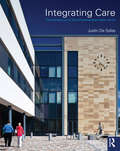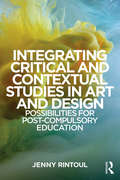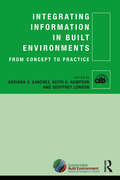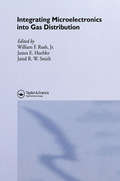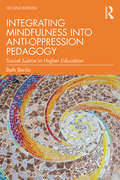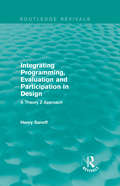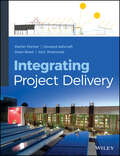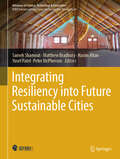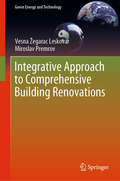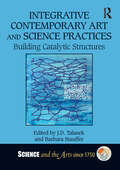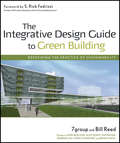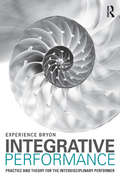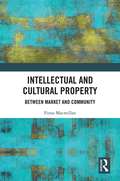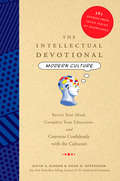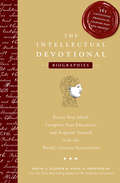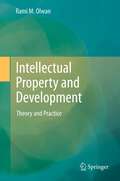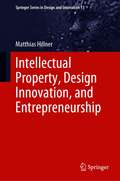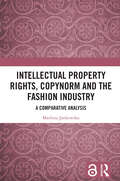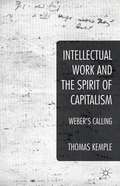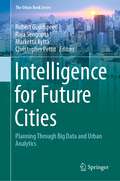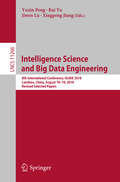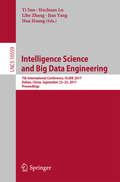- Table View
- List View
Integrating Care: The architecture of the comprehensive health centre
by Justin De SyllasThis book provides a timely review of the contemporary interpretation of the ‘comprehensive health centre’, a building type that was originally advocated by health reformers in the UK in the first half of the twentieth century. The book discusses the development of this idea, the failure under the NHS to apply the idea in practice in the second half of the century and the recent emergence, in all four regions of the UK, of comprehensive health centres providing a wide range of health and social services, often linked to other community facilities. A review of the latest developments in comprehensive health centre design forms the core of the book in the form of detailed case studies of ten exemplary recent projects. Generously illustrated in full colour the case studies include plans, diagrams, photographs and analytical text, providing the reader with detailed information about a range of design approaches. Following devolution, NHS health policies in England, Scotland, Northern Ireland and Wales have begun to diverge and the role of the comprehensive health centre in the current health service of each country is assessed. Aimed at professionals, healthcare facilities providers and policy makers, the book also considers the opportunities for and obstacles facing the further development of the comprehensive health centre as an integral part of the infrastructure of the NHS in the future.
Integrating Critical and Contextual Studies in Art and Design: Possibilities For Post-Compulsory Education
by Jenny RintoulIntegrating Critical and Contextual Studies in Art and Designexamines the relationship between two aspects of art education that appear at times inseparable or even indistinguishable, and at others isolated and in conflict: Critical and Contextual Studies (CCS) and studio practice. Underpinned by international contexts, this book is rooted in British art and design education and draws upon contemporary case studies of teaching and learning in post-compulsory settings in order to analyse and illustrate identities and practices of CCS and its integration. The chapters in this book are divided into three sections that build on one another: 'Discourse and debate'; 'Models, types and tensions'; and 'Proposals and recommendations'. Key issues include: knowledge hierarchies and subject histories and identities; constructions of 'theory' and the symbiotic relationship between theory and practice; models and practices of CCS within current post-compulsory British art and design education; the reification of ubiquitous terms in the fields of art and design and of education: intuition and integration; approaches to curriculum integration, including design and management; and suggestions for integrating CCS in art and design courses, including implications for pedagogy and assessment. Integrating Critical and Contextual Studies in Art and Designoffers a comprehensive analysis of the current drive towards integration within art education, and elucidates what we understand by the theory and practice of integration. It explores the history, theory, teaching and student experience of CCS, and will be of interest to lecturers, teachers and pedagogues involved in art and design as well as researchers and students of art education.
Integrating Information in Built Environments (Cib Ser.)
by Adriana X Sanchez Keith Hampson Geoffrey LondonIn an increasingly globalised built environment industry, achieving higher levels of integration across organisational and software boundaries can lead to improved economic, social and environmental outcomes. This book is the direct result of a collaborative global network of industry and academic researchers spread across nine countries as part of CIB’s (International Council for Research and Innovation in Building and Construction) Task Group 90 (TG90) Information Integration in Construction (IICON). The book provides a broad view of some of the opportunities and challenges brought by integrating information across organisational and system boundaries in the built environment industry. Chapters cover a large range of topics and are separated into three sections: resources, processes and added value. They provide a much-needed international perspective on a current global evolution in the industry and present leading original research and valuable lessons for researchers, industry practitioners, government clients and policy makers across the industry. Key features include: a broad range of topics that are not covered elsewhere in the literature; contributions from a diverse group of industry research leaders from across the globe; exemplar case studies providing real-world examples of where information integration has been a key factor for success or lack thereof has been at the root cause of failure; an analysis of future priority areas for research and development investment as well as their strategic implications for public and private decision-makers; the book will deliver innovation in best practice methodology for information sharing across disciplines and between the design, construction and asset management sectors.
Integrating Innovation in Architecture: Design, Methods and Technology for Progressive Practice and Research (AD Smart)
by Ajla AksamijaToday’s design professionals are faced with challenges on all fronts. They need not only to keep in step with rapid technological changes and the current revolution in design and construction processes, but to lead the industry. This means actively seeking to innovate through design research, raising the bar in building performance and adopting advanced technologies in their practice. In a constant drive to improve design processes and services, how is it possible to implement innovations? And, moreover, to assimilate them in such a way that design, methods and technologies remain fully integrated?Focusing on innovations in architecture, this book covers new materials and design methods, advances in computational design practices, innovations in building technologies and construction techniques, and the integration of research with design. Moreover, it discusses strategies for integrating innovation into design practices, risks and economic impacts. Through numerous case studies, it illustrates how innovations have been implemented on actual architectural projects, and how design and technical innovations are used to improve building performance, as well as design practices in cutting-edge architectural and engineering firms.Projects of all scales and building types are discussed in the book, ranging from small-scale installations, academic and commercial buildings to large-scale mixed-use, healthcare, civic, academic, scientific research and sports facilities. Work from design firms around the globe and of various scales is discussed in the book, including for example Asymptote Architecture, cepezed, CO Architects, Consarc Architects, FAAB Architektura, Gerber Architekten, HOK, IDOM-ACXT, MAD Architects, Morphosis Architects, SDA | Synthesis Design + Architecture, Studiotrope, Perkins+Will, Richter Dahl Rocha & Associés, Snøhetta, Rob Ley Studio, Trahan Architects, UNStudio and Zaha Hadid Architects, among many others.
Integrating Microelectronics into Gas Distribution
by William F. Rush James E. Huebler Jared R. W. SmithThis book considers technical, economic, and policy aspects of application of microelectronics to gas distribution problems. It is based on the first and second IGT symposia on microelectronics in the gas industry to disseminate information on rapidly evolving topics of gas distribution automation.
Integrating Mindfulness into Anti-Oppression Pedagogy: Social Justice in Higher Education
by Beth BerilaDrawing from mindfulness education and social justice teaching, this book explores an effective Anti-Oppression pedagogy for university and college classrooms. Authentic classroom discussions about oppression and diversity can be difficult; a mindful approach allows students to explore their experiences with compassion and to engage in critical inquiry to confront their deeply held beliefs and value systems. This engaging book is full of practical tips for deepening learning, addressing challenging situations, and providing mindfulness practices in anti-oppression classrooms. In this fully revised edition, Dr. Berila positions discussion in the current context and expands exploration of power and implicit bias, transformative learning, and trauma. Integrating Mindfulness into Anti-Oppression Pedagogy is for all higher education professionals interested in and teaching Social Justice pedagogy that empowers and engages students in the complex unlearning of oppression.
Integrating Programming, Evaluation and Participation in Design: A Theory Z Approach (Routledge Revivals Ser.)
by Henry SanoffFirst published in 1992, this book is about making connections that may lead towards a new professionalism, since the past several decades have given rise mainly to new kinds of specialists in the areas of programming, evaluation, and participation. The implications for such integration are far reaching, with profound future effects on the physical environment, the design professions, and the education of designers. The book is split into four sections dealing with facility programming, several forms of evaluation, participatory design, and the application of Theory Z principles. This book will be of interest to students of architecture and design.
Integrating Project Delivery
by Atul Khanzode Dean Reed Howard W. Ashcraft Martin FischerA revolutionary, collaborative approach to design and construction project delivery Integrated Project Delivery is the first book-length discussion of IPD, the emergent project delivery method that draws on each stakeholder's unique knowledge to address problems before they occur. Written by authors with over a decade of research and practical experience, this book provides a primer on IPD for architects, designers, and students interested in this revolutionary approach to design and construction. With a focus on IPD in everyday operation, coverage includes a detailed explanation and analysis of IPD guidelines, and case studies that show how real companies are applying these guidelines on real-world projects. End-of-chapter questions help readers quickly review what they've learned, and the online forum allows them to share their insights and ideas with others who either have or are in the process of implementing IPD themselves. Integrated Project Delivery brings together the owners, architect, engineers, and contractors early in the development stage to ensure that problems are caught early, and to address them in a collaborative way. This book describes the parameters of this new, more efficient approach, with expert insight on real-world implementation. Compare traditional procurement with IPD Understand IPD guidelines, and how they're implemented Examine case studies that illustrate everyday applications Communicate with other IPD adherents in the online forum The IPD approach revolutionizes not only the workflow, but the relationships between the stakeholders – the atmosphere turns collaborative, and the team works together toward a shared goal instead of viewing one another as obstructions to progress. Integrated Project Delivery provides a deep exploration of this approach, with practical guidance and expert insight.
Integrating Resiliency into Future Sustainable Cities (Advances in Science, Technology & Innovation)
by Sameh Shamout Matthew Bradbury Hasim Altan Yusef Patel Peter McPhersonExplore the forefront of urban resilience and sustainability with this groundbreaking collection of research and insights. From the 5th edition of the Resilient and Responsible Architecture and Urbanism (RRAU) conference, this book brings together diverse perspectives and innovative solutions for building resilient and sustainable cities of the future. Featuring contributions from leading scholars, practitioners, and policymakers, this book delves into the multifaceted dimensions of urban resilience at the city, community, and architectural scales. Discover case studies and research on smart urban furniture, medium-density urban planning, crime and urban resilience, green and cool roofs for extreme heat mitigation, and more. Dive into discussions on enhancing social resilience post-COVID-19, urban acupuncture theory for pandemic effects on public spaces, and street retrofitting interventions to boost community resilience. Explore resilient infrastructures, sustainable architectural design principles, and innovative approaches to construction waste management for a more sustainable future. This book serves as an invaluable resource for architects, urban planners, policymakers, researchers, and students interested in shaping the future of our cities. Whether you're seeking practical solutions or theoretical insights, "Integrating Resiliency into Future Sustainable Cities" offers a comprehensive overview of the latest advancements in resilient and sustainable urban development.
Integrative Approach to Comprehensive Building Renovations (Green Energy and Technology)
by Vesna Žegarac Leskovar Miroslav PremrovThis book presents a new approach to building renovation, combining aspects of various professional disciplines, integrating green building design, structural stability, and energy efficiency. It draws attention to several often-overlooked qualities of buildings that should be comprehensively integrated into the context of building renovation.The book presents an overview of the most important renovation approaches according to their scope, intensity, and priorities. Combining basic theoretical knowledge and the authors’ scientific research it emphasizes the importance of simultaneous consideration of energy efficiency and structural stability in building renovation processes. It simultaneously analyses the effects of various renovation steps related to the required level of energy efficiency, while it also proposes the options of building extension with timber-glass upgrade modules as the solution to a shortage of usable floor areas occurring in large cities.This book offers building designers and decision makers a tool for predicting energy savings in building renovation processes and provides useful guidelines for architects, city developers and students studying architecture and civil engineering. Additionally, it demonstrates how specific innovations, e.g., building extensions with timber-glass modules, can assist building industry companies in the planning and development of their future production.The main aim of the current book is to expose various approaches to the renovation of existing buildings and to combine practical experience with existing research, in order to disseminate knowledge and raise awareness on the importance of integrative and interdisciplinary solutions.
Integrative Contemporary Art and Science Practices: Building Catalytic Structures (Science and the Arts since 1750)
by Barbara Stauffer J. D. TalasekContributors investigate the motivation behind scientifically-embedded contemporary art practices as well as art-based scientific research and engagement that attempt to shape society. This edited volume reflects the rapidly developing practices comprising integrative and collaborative work across different knowledge domains (including art and science), the benefit of those processes to the individual, to knowledge production (and its complexity) and ultimately the benefits to society (why it is worth doing). The book will provide an overview of the factors in which the exhibition and performance of scientifically-engaged art inside and outside of traditional museum spaces has instigated cultural and aesthetic transformations and social interactions while presenting a variety of opportunities for educators, scientists, artists and the interested public to critically expand its engagement. The book is intended for scholars interested in collaborative and/or integrative work who study research, methodology, art history, science, and museum studies.
The Integrative Design Guide to Green Building: Redefining the Practice of Sustainabilit
by 7group Bill Reed"The members of 7group and Bill Reed are examples writ large of the kind of leadership that is taking this idea of green building and forming it into reality, by helping change minds, building practice, and design process." —from the Foreword by S. Rick Fedrizzi President, CEO, and Founding Chair, U.S. Green Building Council A whole-building approach to sustainability The integrative design process offers a new path to making better green building decisions and addressing complex issues that threaten living systems. In The Integrative Design Guide to Green Building: Redefining the Practice of Sustainability, 7group's principals and integrative design pioneer Bill Reed introduce design and construction professionals to the concepts of whole building design and whole systems. With integrative thinking that reframes what sustainability means, they provide a how-to guide for architects, designers, engineers, developers, builders, and other professionals on incorporating integrative design into every phase of a project. This practical manual: Explains the philosophy and underpinnings of effective integrative design, addressing systems thinking and building and community design from a whole-living system perspective Details how to implement integrative design from the discovery phase to occupancy, supported by process outlines, itemized tasks, practice examples, case studies, and real-world stories illustrating the nature of this work Explores the deeper understanding of integration that is required to transform architectural practice and our role on the planet This book, both practical and thoughtful, will help you deliver your vision of a sustainable environment. 7group, based in Kutztown, Pennsylvania, includes principals John Boecker, Scot Horst, Tom Keiter, Andrew Lau, Marcus Sheffer, and Brian Toevs, who bring a unique integration of expertise in design, engineering, energy and daylight modeling, materials assessments, commissioning, education, and communications to their work. Internationally recognized thought leaders in the green building movement, they have led countless teams through the practical implementation of integrative design on building projects of all types around the world. 7group also has been directly and deeply involved with the development of the LEED® Green Building Rating System, including experience on more than 100 LEED projects. Scot Horst currently serves as chair of the U.S. Green Building Council's LEED Steering Committee.
Integrative Performance: Practice and Theory for the Interdisciplinary Performer
by Experience BryonIntegrative Performance serves a crucial need of 21st-century performers by providing a transdisciplinary approach to training. Its radical new take on performance practice is designed for a climate that increasingly requires fully rounded artists. The book critiques and interrogates key current practices and offers a proven alternative to the idea that rigorous and effective training must separate the disciplines into discrete categories of acting, singing, and dance. Experience Bryon’s Integrative Performance Practice is a way of working that will profoundly shift how performers engage with their training, conditioning and performance disciplines. It synthesizes the various elements of performance work in order to empower the performer as they practice across disciplines within any genre, style or aesthetic. Theory and practice are balanced throughout, using: Regular box-outs, introducing the work's theoretical underpinnings through quotes, case studies and critical interjections. A full program of exercises ranging from training of specific muscle groups, through working with text, to more subtle structures for integrative awareness and presence. This book is the result of over twenty years of practice and research working with interdisciplinary artists across the world to produce a training that fully prepares performers for the demands of contemporary performance and all its somatic, emotive and vocal possibilities.
Intellectual and Cultural Property: Between Market and Community
by Fiona MacmillanThis book focuses on the fraught relationship between cultural heritage and intellectual property, in their common concern with the creative arts. The competing discourses in international legal instruments around copyright and intangible cultural heritage are the most obvious manifestation of this troubled encounter. However, this characterization of the relationship between intellectual and cultural property is in itself problematic, not least because it reflects a fossilized concept of heritage, divided between things that are fixed and moveable, tangible and intangible. Instead the book maintains that heritage should be conceived as part of a dynamic and mutually constitutive process of community formation. It argues, therefore, for a critically important distinction between the fundamentally different concepts of not only intellectual and cultural heritage/property, but also of the market and the community. For while copyright as a private property right locates all relationships in the context of the market, the context of cultural heritage relationships is the community, of which the market forms a part but does not – and, indeed, should not – control the whole. The concept of cultural property/heritage, then, is a way of resisting the reduction of everything to its value in the market, a way of resisting the commodification, and creeping propertization, of everything. And, as such, the book proposes an alternative basis for expressing and controlling value according to the norms and identity of a community, and not according to the market value of private property rights. An important and original intervention, this book will appeal to academics and practitioners in both intellectual property and the arts, as well as legal and cultural theorists with interests in this area.
The Intellectual Devotional: Revive Your Mind, Complete Your Education, and Converse Confidently with the Cul turati (The Intellectual Devotional Series)
by David S. Kidder Noah D. OppenheimIn the tradition of the instant bestsellers The Intellectual Devotional and The Intellectual Devotional: American History comes the third installment in this indispensable series. <P><P> In The Intellectual Devotional: Modern Culture, authors David S. Kidder and Noah D. Oppenheim explore the fascinating world of contemporary culture to offer 365 daily readings that provide the essential references needed to navigate the world today. <P><P>Quench your intellectual thirst with an overview of the literature, music, film, personalities, trends, sports, and pop references that have defined the way we live. From the Slinky to Star Wars; Beatlemania to Babe Ruth; flappers to fascism—refreshing your memory and dazzling your friends has never been easier, or more fun. <P>Whether you're a trivia genius, pop-culture buff, or avid reader, you'll be riveted by this comprehensive journey through contemporary culture.
The Intellectual Devotional: Revive Your Mind, Complete Your Education, and Acquaint Yourself with the World' s Greatest Personalities (The Intellectual Devotional Series)
by Noah D. Oppenheim David S. KidderThe fifth installment of this bestselling series features 365 captivating entries about the most celebrated personalities in history. <P><P>Like its compulsively readable predecessors, The Intellectual Devotional: Biographies is organized into seven categories, one for each day of the week. With their trademark wit and style, authors David Kidder and Noah Oppenheim offer an array of fascinating facts about major figures from Atilla the Hun to Desmond Tutu. <P>In this daily devotional, learn about: <br>• authors and artists, from Homer and Ovid to Oscar Wilde and Virginia Woolf• leaders, such as Queen Elizabeth I, Abraham Lincoln, Susan B. Anthony, and Napoleon Bonaparte <br>• innovators, from Johannes Gutenberg to Isaac Newton to Werner Heisenberg• philosophers, including Socrates, Epicurus, Friedrich Nietzsche, and Jean-Paul Sartre <br>• rebels and reformers, from Joan of Arc and Spartacus to Galileo and Che Guevara <br>• preachers and prophets, including Lao-tzu, John the Baptist, Martin Luther, and Gandhi <br>• villains, such as Benedict Arnold, Genghis Khan, Ivan the Terrible, and Jack the Ripper <P>This volume shares the personal histories, accomplishments,and troubles of 365 people who have left an indelible mark on the world.
The Intellectual Education of the Italian Renaissance Artist
by Angela DressenScholars have traditionally viewed the Italian Renaissance artist as a gifted, but poorly educated craftsman whose complex and demanding works were created with the assistance of a more educated advisor. These assumptions are, in part, based on research that has focused primarily on the artist's social rank and workshop training. In this volume, Angela Dressen explores the range of educational opportunities that were available to the Italian Renaissance artist. Considering artistic formation within the history of education, Dressen focuses on the training of highly skilled, average artists, revealing a general level of learning that was much more substantial than has been assumed. She emphasizes the role of mediators who had a particular interest in augmenting artists' knowledge, and highlights how artists used Latin and vernacular texts to gain additional knowledge that they avidly sought. Dressen's volume brings new insights into a topic at the intersection of early modern intellectual, educational, and art history.
Intellectual Property and Development
by Rami M. OlwanThe book examines the correlation between Intellectual Property Law - notably copyright - on the one hand and social and economic development on the other. The main focus of the initial overview is on historical, legal, economic and cultural aspects. Building on that, the work subsequently investigates how intellectual property systems have to be designed in order to foster social and economic growth in developing countries and puts forward theoretical and practical solutions that should be considered and implemented by policy makers, legal experts and the Word Intellectual Property Organization (WIPO).
Intellectual Property, Design Innovation, and Entrepreneurship (Springer Series in Design and Innovation #11)
by Matthias HillnerThis book focuses on intellectual property (IP) in the context of product innovation and design-led start-up management. A distinguished feature is that it analyses innovation-related scenarios within their continuously changing contexts. IP is discussed in relation to the way in which its value changes over time as a venture matures. The book reveals how IP strategies can enhance a start-up’s survival prospects and its growth potential if they are connected systematically to other business development attributes. Being mainly addressed to enterprising designers, it may also support business administration programmes, innovation hubs, design educators, incubator managers, as well as business coaches and IP attorneys who support creatives and inventors. All in all, this book offers a unique and timely strategic guidance in the field of design and innovation management. “Design and design rights have long been overlooked in the plethora of studies on the links between IPR and innovation. Matthias Hillner’s thoughtful and eloquent journey provides a contemporary and meaningful analysis which will no doubt assist governments, economists, academics and designers’ better understanding of design in the context of successful business strategies and IPR. Given design’s significant contribution to global economies, I am confident it will offer much needed guidance.”Dids Macdonald OBE, founder CEO of Anticopying in Design (ACID)"This is an immensely practical book for designers and entrepreneurs who want to understand the issues of IP, product innovation, and business development. With clear explanations, many vivid examples, and strategically useful tips, it will be a valuable resource for creative minds at all levels of experience. A serious book but written with a sensitive touch on how to protect new ideas." Richard Buchanan, Professor of Design, Management, and Innovation, Weatherhead School of Management, Case Western Reserve University
Intellectual Property Rights, Copynorm and the Fashion Industry: A Comparative Analysis
by Marlena JankowskaThis book traces the development of the fashion industry, providing insight into the business and, in particular, its interrelations with copyright law. The book explores how the greatest haute couture fashion designers also had a sense for business and that their attention to copyright was one of the weapons in protecting their market position. The work also confronts the peculiarities of the fashion industry as a means of demonstrating the importance of intellectual property protection while pointing out the many challenges involved. A central aim is to provide a copyrightability test for fashion goods based on detailed analysis of the legal regulations in the USA and EU countries, specifically Italy, France, the Netherlands, Germany and Poland. The book will be of interest to researchers and academics working in the areas of Intellectual Property Law, Copyright Law, Business Law, Fashion Law and Design.
Intellectual Property Rights, Copynorm and the Fashion Industry: A Comparative Analysis
by Marlena JankowskaThis book traces the development of the fashion industry, providing insight into the business and, in particular, its interrelations with copyright law. The book explores how the greatest haute couture fashion designers also had a sense for business and that their attention to copyright was one of the weapons in protecting their market position. The work also confronts the peculiarities of the fashion industry as a means of demonstrating the importance of intellectual property protection while pointing out the many challenges involved. A central aim is to provide a copyrightability test for fashion goods based on detailed analysis of the legal regulations in the USA and EU countries, specifically Italy, France, the Netherlands, Germany and Poland. The book will be of interest to researchers and academics working in the areas of Intellectual Property Law, Copyright Law, Business Law, Fashion Law and Design.
Intellectual Work and the Spirit of Capitalism
by Thomas KempleThis book treats three lectures that Weber gave in the last decade of his career as a podium or prism from which to approach his best-known treatises and essays on the rise of occidental capitalism. His remarks on 'Technology and Culture' (1910) and his famous 'Science as a Vocation' (1917) and 'Politics as a Vocation' (1919 lectures) offer a standpoint for assessing the contemporary relevance of Weber''s notion of ''interpretive understanding'', including the place of ideal types and value-judgments in sociology, as well as the use of rhetorical techniques and literary methods in scholarly discourse more generally. These public moments invite us to consider how both his most celebrated and least known arguments about the origins of the ''spirit'' of modern capitalism and the fateful force of bureaucracy continue to raise questions about the prospect and promise of intellectual work that still concern us today.
Intelligence for Future Cities: Planning Through Big Data and Urban Analytics (The Urban Book Series)
by Robert Goodspeed Raja Sengupta Marketta Kyttä Christopher PettitThis book contains a selection of the best papers presented at the Computational Urban Planning and Urban Management (CUPUM) conference, held in June 2023 at McGill University in Montreal, Quebec. Major themes of this book are smart cities, urban big data, and shared mobility. This book also contains chapters with cutting-edge research on urban modeling, walkability and bikeability analysis, and planning support systems (PSS).
Intelligence Science and Big Data Engineering: 8th International Conference, IScIDE 2018, Lanzhou, China, August 18–19, 2018, Revised Selected Papers (Lecture Notes in Computer Science #11266)
by Yuxin Peng Kai Yu Jiwen Lu Xingpeng JiangThis book constitutes the proceedings of the 8th International Conference on Intelligence Science and Big DataEngineering, IScIDE 2018, held in Lanzhou, China, in August 2018.The 59 full papers presented in this book were carefully reviewed and selected from 121 submissions.They are grouped in topical sections on robots and intelligent systems; statistics and learning; deep learning; objects and language; classification and clustering; imaging; and biomedical signal processing.
Intelligence Science and Big Data Engineering: 7th International Conference, IScIDE 2017, Dalian, China, September 22-23, 2017, Proceedings (Lecture Notes in Computer Science #10559)
by Yi Sun, Huchuan Lu, Lihe Zhang, Jian Yang and Hua HuangThis book constitutes the proceedings of the 7th International Conference on Intelligence Science and Big Data Engineering, IScIDE 2017, held in Dalian, China, in September 2017.The 48 full papers and 14 short papers presented in this volume were carefully reviewed and selected from 121 submissions. They deal with statistics and learning; deep neural networks; faces and people; objects; classification and clustering; imaging; biomedical signal processing; and recommendation.
